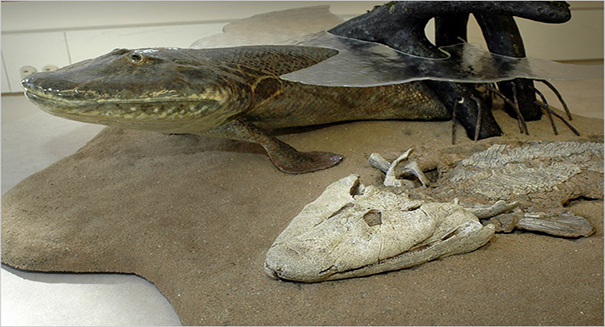
New fossil provides crucial evidence of missing link between land and sea-dwelling animals
Researchers at Drexel University have discovered new fossil remains that provide a crucial link in our understanding of how our ultra-ancient ancestors made the move from sea to land. The 375 million year old fossil is from the pelvic region of Tiktaalik roseae, believed to be a transitional species. What’s so shocking is that the fossil indicates that animals developed increasingly stronger rear appendages before they sprouted legs.
That may not be so surprising to some, and in fact downright logical: If you’re an animal that wishes to exist on land, it would be awfully helpful to work on growing a set of legs first. That makes sense now, but earlier, long-held theories suggested that the first intrepid explorers to venture out of the sea did so by using their front limbs, with the rear limbs playing a very small role. Previous research suggested that the evolution of legs started with organisms already on land.
A lobe-finned fish with a broad flat head and sharp teeth, Tiktaalik roseae was a fearsome specimen, growing to nearly nine feet long and having a broad, flat head and sharp teeth, not unlike a crocodile. While it had normal fish features like scales and gills, it also sported primitive lungs. That, combined with partial wrists, shoulders and elbows on its front limbs make it among the most convincing examples of a species that bridges the gap between land and sea.
What’s unique about this specimen is that it’s the first time scientists have gotten a look at the rear parts of Tiktaalik roseae (previous samples were only of the front half of the fish). The part that has researchers so excited is the pelvic region, which is almost as developed as the animal’s shoulder cradle. That’s a feature typically reserved for land-dwelling tetrapods, indicating that the evolution of legs began in the ocean, not on land.
“This is an amazing pelvis, particularly the hip socket, which is very different from anything that we knew of in the lineage leading up to limbed vertebrates,” Daeschler said. “Tiktaalik was a combination of primitive and advanced features. Here, not only were the features distinct, but they suggest an advanced function. They appear to have used the fin in a way that’s more suggestive of the way a limb gets used.”
Though it’s believed that Tiktaalik was for the most part very fish-like in its behavior, there’s nothing to suggest that it couldn’t have used its sturdy rear limbs and primitive pelvis to cover a wider range of locomotive possibilities. African lungfish, for example, have been observed using their hind fins to “walk” along the seafloor.
Leave a Reply